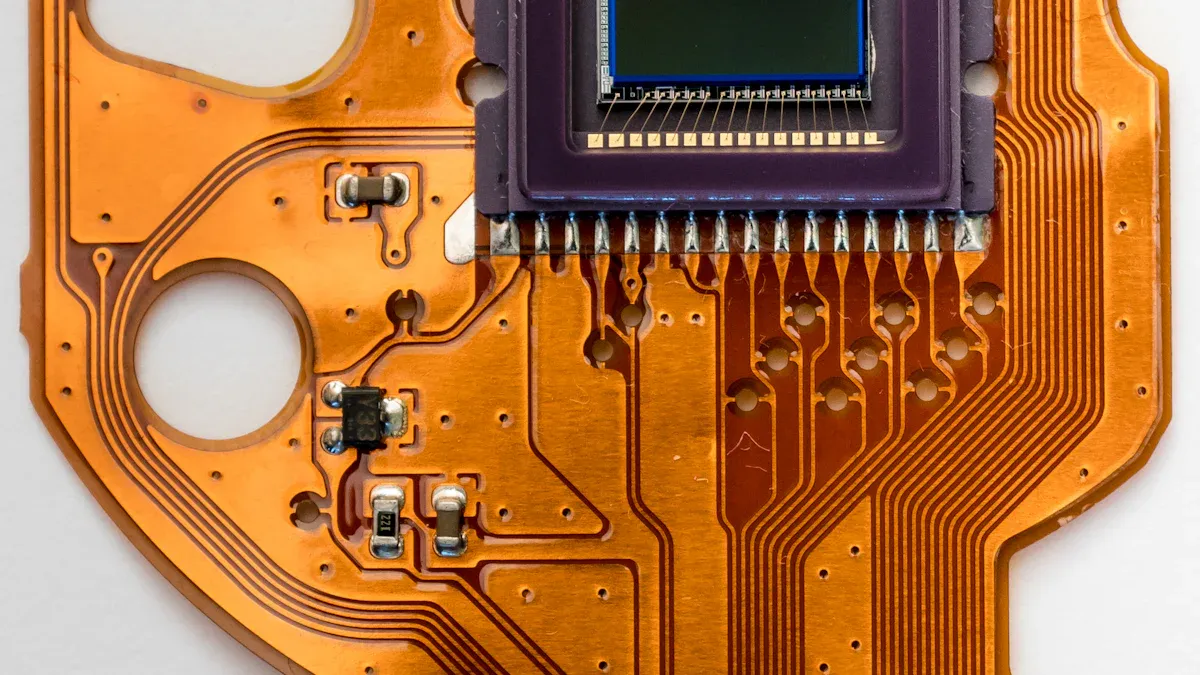Flexible PCB technology transforms LED power flex PCB solutions with unmatched flexibility, lightweight construction, and advanced heat management. Manufacturers prefer flexible PCB options because they deliver durability, resist dust and moisture, and enable compact designs such as flexible LED strip and curved LED light strips. These qualities make LED power flex PCB the top choice for everything from smart lighting to wearables. This approach delivers longer-lasting, energy-efficient lighting in even the most demanding environments.
Key Takeaways
- Flexible PCBs bend and fit into tight spaces, enabling creative and compact LED designs like curved strips and wearables.
- They are lightweight and thin, which reduces product size, weight, and shipping costs while improving portability.
- Flexible PCBs manage heat well using special materials, helping LEDs last longer and perform better.
- These PCBs resist damage from bending, vibration, and moisture, making them reliable for harsh environments.
- Compared to rigid PCBs, flexible PCBs offer more design freedom and durability, though they may cost more but save time in assembly.
What Is a Flexible PCB?

Structure and Materials
A flexible PCB stands out because of its unique structure and advanced materials. Manufacturers design these circuits to bend, twist, and fit into tight spaces without losing performance. The core of a flexible PCB is the polyimide substrate, which offers excellent heat resistance and durability. Copper forms the main conductive layer, allowing efficient electrical flow. The combination of these materials ensures that the flexible PCB can handle the demands of modern LED power solutions.
The materials used in a flexible printed circuit board not only provide flexibility but also improve heat dissipation and reliability. Thermally conductive adhesives and thin, flexible layers help manage heat, which is critical for LED lighting. This design reduces the need for connectors and solder joints, lowering the risk of failure and increasing the lifespan of LED products.
Here is a breakdown of the main structural components and materials:
| Structural Component | Description |
|---|---|
| Polyimide Substrate | Heat-resistant, durable flexible substrate commonly used in LED PCBs. |
| Copper Conductive Layer | Forms the electrical circuit; thickness affects heat dissipation and electrical performance. |
| Single-Layer PCB | One copper layer on polyimide substrate; thinner, lighter, with solder mask and silkscreen layers. |
| Double-Layer PCB | Two copper layers sandwiching the polyimide substrate; allows solder mask on both sides; thicker and heavier. |
| Solder Mask | Protective polymer coating to prevent solder bridging and damage. |
| Silkscreen | Epoxy layer for component labeling and identification. |
Flexible vs. Rigid PCB
Flexible PCBs and rigid PCBs differ in several important ways. Flexible PCBs use materials like polyimide or polyester, which allow them to bend and twist. Rigid PCBs use solid substrates such as FR-4, making them inflexible but strong. Flexible PCBs use thinner copper layers, which support bending and folding without breaking connections. Rigid PCBs have thicker copper traces and offer better heat dissipation due to their solid construction.
| Aspect | Rigid PCBs | Flexible PCBs |
|---|---|---|
| Substrate Material | Solid, inflexible (e.g., FR-4) | Flexible materials (e.g., polyimide, PET, PEN) |
| Copper Traces | Laminated copper, thicker | Thinner, electrodeposited copper |
| Structural Flexibility | Inflexible, rigid | Can bend, fold, twist |
| Protective Layer | Solder mask | Coverlays made of flexible substrate material |
| Mechanical Support | N/A | Stiffeners at connection points |
| Thermal Management | Superior due to solid construction | Varies with width and design |
| Manufacturing Process | Standard lamination | Specialized layering for flexibility |
Flexible PCBs may cost more to manufacture, but they reduce assembly time and improve reliability. Their ability to fit into compact or curved spaces makes them the best choice for advanced LED applications.
Benefits of Flexible PCB
Lightweight and Thin
Flexible PCB technology delivers a major advantage in weight reduction. Designers choose flexible PCBs for LED power flex pcb solutions because these circuits weigh much less than traditional rigid boards. This weight savings matters most in applications where every gram counts, such as aerospace, medical devices, and portable lighting. The thin profile of flexible PCBs also allows engineers to create ultra-slim products, including flexible led strip and compact drivers.
| Feature | Flexible PCB Thickness | Rigid PCB Thickness |
|---|---|---|
| Typical Thickness | 0.05 - 0.1 mm | 0.8 - 1.6 mm |
| Substrate Material | Polyimide (flexible) | FR-4 (rigid) |
Flexible PCBs typically measure only 0.05 to 0.1 mm thick, while rigid PCBs range from 0.8 to 1.6 mm. This difference enables flexible PCBs to fit into tight spaces and support creative LED designs. The lightweight construction also eliminates the need for bulky connectors and wire harnesses, reducing both the size and the weight of the final product. As a result, manufacturers can deliver high brightness and high efficiency in smaller, lighter LED modules.
Tip: Lighter and thinner LED power flex pcb designs not only improve portability but also reduce shipping and installation costs.
Superior Heat Dissipation
Efficient heat management is critical for any driver in LED lighting. Flexible PCBs excel in this area, helping to prevent internal heat buildup that can damage LED chips and reduce performance. By using materials with high thermal conductivity, such as silicone and copper, flexible PCBs draw heat away from sensitive components. This design keeps LEDs operating at optimal temperatures, which extends their lifespan and maintains consistent light output.
- Superior heat dissipation prevents internal heat buildup, slowing the aging of LED chips and phosphors.
- Efficient thermal management reduces light decay and extends the lifespan of LED modules.
- High-conductivity materials, like silicone and copper, enhance heat transfer.
- Advanced technologies, such as TwinFlex™, combine flexible circuits with copper belts for improved mechanical strength and heat dissipation.
- Proper thermal design, including PCB thickness and layout, reduces thermal stress and mechanical damage, ensuring drivers operate reliably.
Flexible PCBs also support the integration of thermal vias and heat sinks, further improving cooling. This advantage is especially important for high-power drivers and high-density LED layouts, where overheating can lead to rapid failure. By keeping LEDs cool, flexible PCBs help maintain high efficiency and stable performance over time.
Durability and Reliability
Flexible PCBs offer outstanding durability, even in environments with constant bending, vibration, or movement. Engineers select these circuits for LED power flex pcb applications that demand long-term reliability, such as automotive lighting, industrial equipment, and wearable devices. The use of polyimide substrates and rolled annealed copper increases mechanical endurance, allowing the PCB to withstand repeated flexing without cracking or delaminating.
- Flexible PCBs resist cracking and delamination when bent or twisted.
- Reinforced areas with stiffeners and strain reliefs protect critical connections.
- Materials like polyimide and adhesiveless laminates improve mechanical strength.
- Vibration-damping materials and stiffeners reduce the risk of solder joint fatigue.
- Manufacturers validate durability through flex cycle testing, twist testing, and environmental stress simulations.
Flexible PCBs also eliminate many potential failure points by removing the need for mechanical connectors and excess wiring. This design reduces wiring errors and improves signal integrity, especially in high-density layouts. Drivers benefit from this reliability, as fewer interconnects mean fewer chances for failure. The thin layers and compact structure of flexible PCBs allow for more LEDs and drivers in a smaller space, supporting innovative designs and consistent performance.
Note: Flexible PCBs enable unique LED forms and support high-density layouts, making them the preferred choice for advanced lighting solutions.
LED Power Flex PCB Applications
Creative LED Designs
Designers use flexible PCB technology to unlock new possibilities in lighting. They create curved LED light strips that wrap around architectural features, display lighting that follows unique shapes, and three-dimensional packaging for immersive effects. Flexible LED strip products can bend, twist, and fit into spaces where rigid boards cannot go. This flexibility allows for high brightness and uniform illumination, even on complex surfaces. Dynamic lighting effects become possible, giving designers the freedom to build custom shapes and configurations. For example, vehicle interiors now feature ambient lighting systems that enhance the driving experience. Smart home lighting systems use flexible LED strip solutions to blend seamlessly into modern spaces. Healthcare tools benefit from small, bendable lighting that improves visibility during procedures.
Flexible PCB technology enables ultra-thin, lightweight, and bendable LED panels. These panels integrate easily into curved, cylindrical, or wave-shaped surfaces, supporting creative LED strip lights applications.
Compact and Wearable Devices
Flexible PCB solutions drive the miniaturization of wearable technology. Engineers select thin, lightweight materials that maintain electrical integrity, even when bent or twisted. This approach allows for compact, comfortable devices that fit the human body. Wearable health monitors, smartwatches, and fitness trackers all rely on flexible PCB designs. These circuits reduce the need for bulky connectors, freeing space for advanced features like sensors and wireless modules. The result is a sleek, unobtrusive product that delivers reliable performance. Flexible PCB technology also supports dense integration of components, which is essential for high-performance wearables. Drivers in these devices must remain small and efficient, so engineers use flexible PCB layouts to maximize space and functionality.
- Flexible PCBs bend and conform to the body, enabling ergonomic designs.
- They reduce device weight and thickness, improving comfort.
- Miniaturization supports more features in a smaller footprint.
Harsh Environments
Flexible PCB technology excels in demanding settings such as automotive and industrial applications. These environments expose LED power flex PCB assemblies to heat, vibration, and moisture. Engineers choose advanced materials like polyimide and liquid crystal polymers to ensure durability and thermal stability. Flexible PCBs resist cracking and delamination, even under constant movement or extreme temperatures. Automotive lighting systems use robust connectors and high-performance drivers to maintain reliability. Industrial automation systems benefit from flexible PCBs that withstand mechanical stress and chemical exposure.
- Polyimide substrates offer low moisture absorption, reducing corrosion risks.
- Protective coatings shield circuits from dust, chemicals, and moisture.
- Thermal management features, such as heat sinks and thermal vias, dissipate heat from drivers and LEDs.
Flexible PCB assemblies simplify installation and improve uniform lighting. They reduce wiring errors and eliminate bulky connectors, making assembly faster and more reliable. As industries focus on energy efficiency and sustainability, flexible PCB solutions support eco-friendly designs with lead-free soldering and biodegradable substrates. The growth of electric vehicles, IoT, and wearable devices continues to drive demand for flexible PCB technology in LED driver topologies.
Flexible PCB vs. Rigid PCB for LEDs
Performance Comparison
Flexible PCBs and rigid PCBs each bring unique strengths to LED lighting. Flexible PCBs use lightweight polyimide or polyester, which allows them to bend and fit into creative spaces. Rigid PCBs rely on metal cores or aluminum substrates, making them heavier but excellent at managing heat. The choice of substrate directly affects the driver’s ability to keep LEDs cool and efficient.
| Aspect | Flexible PCBs (FPCBs) | Rigid PCBs (e.g., Aluminum Substrate) |
|---|---|---|
| Substrate Material | Polyimide, Polyester | Metal core, Aluminum |
| Thermal Conductivity | Low (Kapton ~0.12 W/m-K) | High (acts as heat sink) |
| Heat Dissipation | Lower, heat builds up easily | Superior, keeps LEDs cooler |
| LED Brightness & Efficiency | Can decrease if heat builds up | Higher due to better thermal management |
| Flexibility | High, fits complex shapes | Low, fixed shapes |
| LED Lifespan | Shorter if heat is not managed | Longer, better thermal control |
A driver on a rigid PCB benefits from superior heat dissipation. This keeps LED temperature low, which means higher brightness and longer lifespan. Flexible PCBs can struggle with heat, especially in high-power led driver topologies. Increasing copper thickness helps, but rigid PCBs still lead in thermal performance. For applications where design freedom matters more than maximum efficiency, flexible PCBs remain the top choice.
Reliability and Assembly
Assembly processes differ greatly between flexible and rigid PCBs. Flexible PCBs require special layering and protective coatings to maintain flexibility. Manufacturers use polyimide film and coverlay lamination. They test each driver with bend and flex cycles to ensure durability. Rigid PCBs use FR4 material and a solder mask, making assembly more straightforward.
- Flexible PCBs need encapsulation to protect circuits during bending.
- Rigid PCBs allow components to be soldered directly onto a solid board.
- Flexible PCBs require extra steps, such as laser cutting and flex testing.
- Rigid PCBs follow a standardized process, reducing assembly time.
A driver built on a flexible PCB can handle vibration and movement, which is vital for wearables and automotive lighting. However, the assembly process is more complex. Flexible PCBs support advanced led driver topologies that demand compact layouts and high reliability. Rigid PCBs suit environments where the driver remains stationary and heat management is critical. Both options deliver strong performance, but flexible PCBs offer unmatched versatility for innovative LED designs.
Flexible PCBs deliver unmatched flexibility, superior heat management, and design freedom for modern LED solutions. Engineers achieve compact, energy-efficient, and reliable lighting by choosing advanced materials and innovative layouts.
Industry experts predict strong growth as new materials and manufacturing methods unlock even more possibilities for flexible LED products.
Flexible PCBs support sustainability, reduce waste, and enable creative designs. Now is the time to embrace flexible PCBs for next-generation LED projects and shape the future of lighting technology.
FAQ
What makes flexible PCBs better for LED lighting than rigid PCBs?
Flexible PCBs allow designers to create unique shapes and fit LEDs into tight spaces. They also improve durability and reduce weight. These benefits help companies deliver more reliable and creative lighting products.
Can flexible PCBs handle high temperatures in LED applications?
Yes. Flexible PCBs use materials like polyimide that resist heat. This feature keeps LEDs cool and extends their lifespan. Proper thermal management ensures stable performance in demanding environments.
Are flexible PCBs more expensive than rigid PCBs?
Flexible PCBs often cost more to manufacture. However, they reduce assembly time and lower maintenance costs. Companies save money in the long run by choosing flexible PCBs for advanced LED projects.
How do flexible PCBs improve LED product reliability?
Flexible PCBs eliminate many connectors and wires. This design reduces failure points and improves signal integrity. Products last longer and perform better, even in harsh conditions.
Where can companies use flexible PCBs in LED solutions?
- Wearable devices
- Automotive lighting
- Smart home systems
- Industrial equipment
Flexible PCBs adapt to many applications, making them the top choice for innovative LED designs.










 2025-07-15
2025-07-15
 BEST
BEST

.png)
.png)
.png)
.png)

.png)

